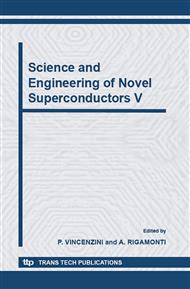[1]
H. Fujimoto, QR of RTRI, Vol. 45, No. 4, Nov. 2004, pp.197-202.
Google Scholar
[2]
The Survey on Transport Energy, 1999 (Ministry of Transport, in Japanese).
Google Scholar
[3]
H. Fujimoto, National Convention Record, IEEJ, (3. 2001), S18-6 (in Japanese).
Google Scholar
[4]
K. Funaki et al., IEEE Trans. Appl. Supercond., 7-2 (1997) 824-827.
Google Scholar
[5]
U. Henning et al., Proc. World Congress on Railway Research (WCRR99), 1999, Tokyo, Japan.
Google Scholar
[6]
H. Hata et al., Abstracts of CSJ Conference, Vol. 51, B1-9, 1994 (in Japanese).
Google Scholar
[7]
H. Hata et al., Proc. 59th Meeting on Cryogenics and Supercond., 1998, B2-2, p.133 (in Japanese).
Google Scholar
[8]
H. Fujimoto et al., Physica C, vol. 341-348, Part 4, (11. 2000), pp.2625-2626.
Google Scholar
[9]
H. Hata et al., IEEJ, TER and LD, TER-00-50, LD-00-77, (7. 2000), 55-60 (in Japanese).
Google Scholar
[10]
H. Hata et al., Intl. Conf. Railway Traction Systems Proc. Vol. 2, May 2001, pp.87-98.
Google Scholar
[11]
H. Hata et al., Intl. Conf. Railway Traction Systems, May 2002, Capri.
Google Scholar
[12]
H. Kamijo et al., IEEE Trans. Appl. Supercond., 13, No. 2, July 2003, pp.2337-2340.
Google Scholar
[13]
H. Kamijo et al., Trans. Intl. Cryogenic Materials Conf. - ICMC, 50B, 2004, pp.871-878.
Google Scholar
[14]
H. Kamijo et al., IEEE Trans. Appl. Supercond., Vol. 15, Issue 2, Part 2, 2005, pp.1875-1878.
Google Scholar
[15]
K. Ikeda et al., RTRI Report, Vol. 17, No. 5, May 2003 (in Japanese).
Google Scholar
[16]
H. Hata et al., Proc. Intl. Conf. Ship Propulsion and Railway Traction Systems, SPRTS, (2005).
Google Scholar
[17]
H. Hata et al., QR of RTRI, Vol. 47, No. 1, Feb. 2006, pp.24-27.
Google Scholar
[18]
Railway Technical Research Institute (RTRI), URL Home page, http: /www. rtri. or. jp.
Google Scholar
[19]
Japan Railway & Transport Review, e. g. No. 16 (6-1998), No. 17 (9-1998), No. 42 (12-2005).
Google Scholar
[20]
Japanese Railway Tech Today, RTRI and EJRCF, Dec. (2001).
Google Scholar
[21]
S.W. Schwenterly et al., IEEE Trans. Appl. Supercond., Vol. 9, No. 2, June 1999, 680.
Google Scholar
[22]
M. Leghissa, et al., Physica C, Vol. 372-376, Part 3, Aug 2002, pp.1688-1693.
Google Scholar
[23]
K. Funaki et al. , Cryogenics, Vol. 38, Issue 2, Feb. 1998, pp.211-220.
Google Scholar
[24]
H. Riemersma et al, IEEE Trans. Power Appar. Syst., 100, 1981, p.3398.
Google Scholar
[25]
H. Zueger, Cryogenics 38 (1998) pp.1169-1172.
Google Scholar
[26]
S.P. Mehta et al., IEEE Spectrum, Vol. 34, Issue 7, Jul 1997, pp.43-49.
Google Scholar
[27]
L. Masur et al., IEEE Trans. Appl. Supercond. 11 (2001), p.3256.
Google Scholar
[28]
S. Kobayashi et al., IEEE Trans. Appl. Supercond., 2005, Vol. 15, Issue 2, Part 3, p.2534.
Google Scholar


